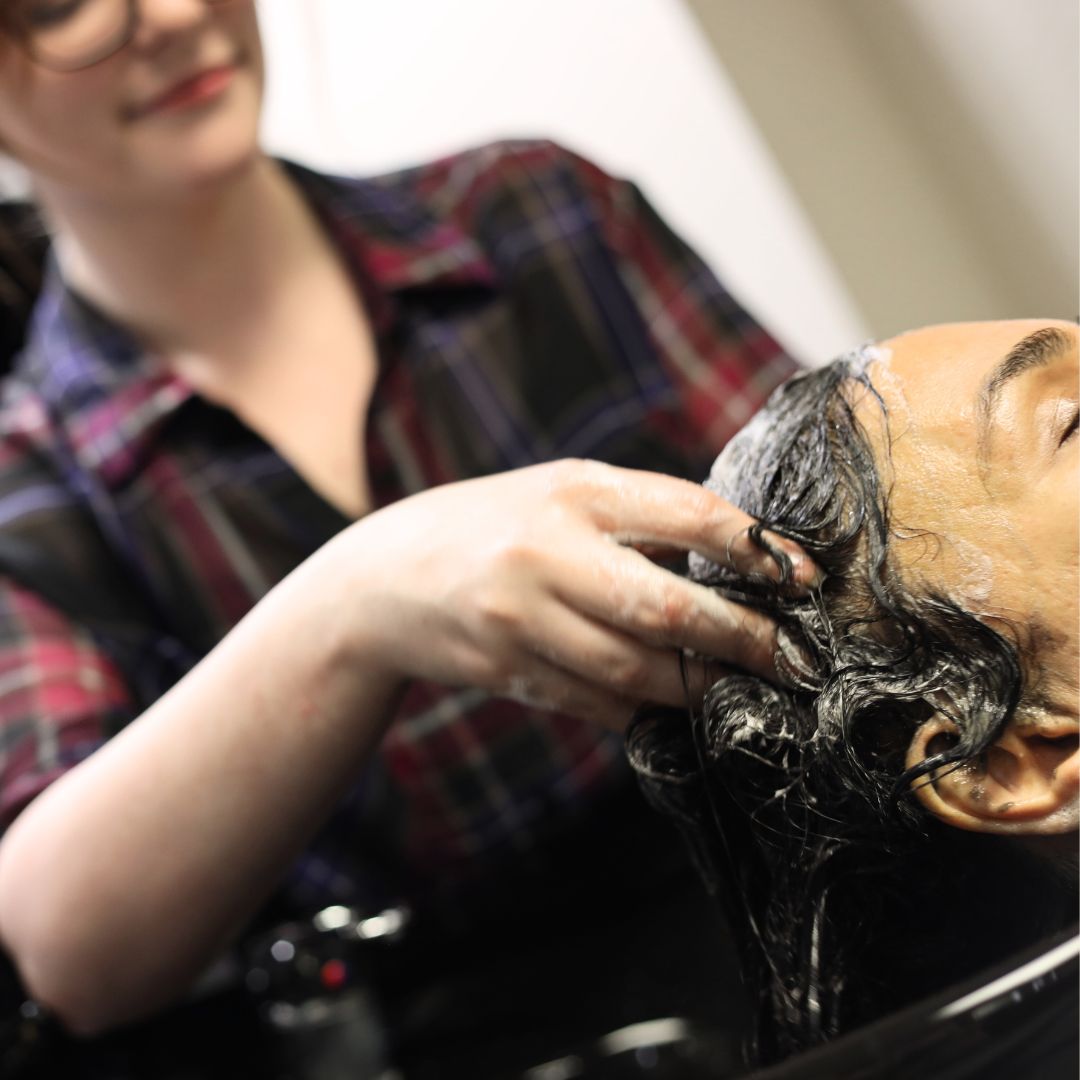Why Texas Air Quality is Damaging Your Skin and Scalp (Expert Guide)

Texas residents face more challenges than just the scorching heat - we're dealing with unprecedented health and skin (therefore SCALP) problems due to pollution!
Our state creates the perfect environment for skin and scalp issues with its unique mix of year-round airborne allergens and poor air quality. Local air quality often fails to meet the World Health Organization's guidelines, which leads to increased oxidative stress and skin damage. The combination of pollutants and hard water can break down our skin's natural barrier. This triggers various conditions from eczema to premature aging and major scalp issues. Texas's air quality needs our immediate attention, and we must take steps to protect ourselves.
Please note that, unlike many of our fun and upbeat blogs, this particular one is far more serious as air pollution and its impact on skin and scalp health is causing detrimental damage!
Current Air Quality Issues in Texas
Texas air quality faces serious challenges based on recent data. Industrial facilities released more than 1 million pounds of excess pollution in just four cold days during January 2024. Companies discharged more than 170 million pounds of unauthorized toxins into the air during 2019, which made the situation worse.
Major pollutants in Texas cities
These pollutants make our air quality worse:
-
Particulate Matter (PM2.5): Tiny particles that can get deep into your lungs (anything that your body absorbs can — and often does — impact your skin!)
-
Ground-level ozone: Shows up in hot, sunny weather
-
Carbon monoxide: Comes mainly from industrial processes
-
Sulfur dioxide: High levels exist in industrial areas
Industrial impact on air quality
The Houston Ship Channel houses America's largest petrochemical complex and affects the region's air quality. Many facilities along this 52-mile waterway keep breaking clean air rules. The ExxonMobil Baytown Complex broke air pollution rules 1,013 times in the last twenty years, with 77 violations since 2020. The LyondellBasell Channelview Complex had 463 violations, and 61 of them happened since 2020.
Seasonal air quality patterns
Weather changes play a vital role in pollution levels. Industrial facilities often release more emissions during cold weather due to operational problems. Pipeline operators in the Permian Basin released almost a million pounds of methane gas last summer when temperatures soared. Bad weather causes shutdowns and equipment failures that spike pollution levels.
The Texas Commission on Environmental Quality (TCEQ) runs more than 200 monitoring stations that serve over 25 million Texans. These stations show pollution peaks during specific weather conditions. Sunlight mixed with high temperatures speeds up the creation of harmful ground-level ozone that affects big cities the most.
How Air Pollution Damages Your Skin
Our skin protects us from environmental threats. This makes it vulnerable to harmful effects of air pollution. Studies show that airborne pollutants can enter our skin through hair follicles or pass through skin layers directly.
Direct effects on skin barrier
We learned that air pollution damages our skin's protective barrier. Tests show that particulate matter (PM) weakens the epidermal barrier as soon as it touches the skin surface. These pollutants then set off a chain of harmful reactions. The skin loses more water and the connections between skin cells become weak.
Deep inside our skin, the chemical changes are serious. Urban residents' skin shows several problems:
-
Lower squalene levels
-
Less vitamin E content
-
Reduced ATP (energy) availability
-
More damaged proteins
Signs of pollution damage
The skin shows several visible signs of air pollutant exposure. A large study of 400 women between 70-80 years found a strong link between air pollution and external aging signs. The results showed that more soot and traffic particles led to 20% more pigment spots on the forehead and cheeks.
Pollutants harm our skin in multiple ways. They create harmful molecules called quinones that produce reactive oxygen species (ROS). This overwhelms our skin's natural defenses against oxidation. The process creates an endless loop of inflammation and tissue damage that leads to early aging and other skin problems.
Most affected skin areas
Research points out that some parts of our skin are more likely to show pollution damage. The face and shows the most obvious effects, especially on the forehead and cheeks. These areas get more pigment spots and deeper wrinkles from exposure to traffic-related particles.
Particle size makes a difference in how much damage occurs. Studies show that smaller PM2.5 particles cause more harm than larger PM10 particles. This creates a bigger problem because these tiny particles can reach deeper skin layers and cause lasting damage to both dermis and epidermis.
Common Scalp Problems from Poor Air Quality
Research shows that microscopic pollutants go deeper than we used to think and affect our scalp and hair follicles in multiple ways.
Scalp inflammation signs
Our scalp reacts to air pollution through several distinct symptoms. We noticed that exposure to particulate matter triggers excess sebum production and causes pronounced inflammation. These reactions show up as:
-
Persistent scalp redness and swelling
-
Intense itching and prickling sensations
-
Painful bumps around hair roots
-
Increased flaking and dandruff
-
Excess oil in specific areas
These symptoms might seem minor at first but can quickly turn into serious conditions. Research shows that urban particulate matter can get into hair follicles through both transfollicular and transdermal routes and cause chronic inflammation.
Hair follicle damage
Pollution's effect on hair follicles goes beyond surface irritation. Lab studies show that exposure to particulate matter lowers levels of β-catenin, a vital protein that controls hair growth and morphogenesis. This damage happens in proportion to pollution levels - more pollution means bigger drops in protein levels.
The way cells get damaged raises serious concerns. Pollutants that build up in hair follicles cause widespread cell death across almost all keratinocyte regions. The damage extends to:
-
The outer root sheath
-
Inner root sheath layer
-
Sebaceous glands
-
Dermal papilla cells
Research has found that air pollution speeds up the natural breakdown of hair cortex and causes cuticle delamination. Without doubt, UV exposure combined with pollution creates more severe cortical damage, especially around melanosomes.
The oxidative stress from these environmental factors overwhelms the scalp's natural defenses. Studies show that constant exposure to particulate matter makes the body produce reactive oxygen species, which causes DNA damage and increased cell death. This complex process explains why people in heavily polluted areas often experience faster hair thinning and more scalp sensitivity.
Who Is Most at Risk?
People with certain skin types face higher risks from air pollution. Research shows clear patterns of vulnerability across different population groups.
Sensitive skin types
People with sensitive skin struggle more because their skin barrier doesn't work as well. The number of sensitive skin cases has risen in industrialized regions, particularly among Asian skin types. These people often experience:
-
Immediate discomfort when exposed to pollutants
-
Strong inflammatory responses
-
Higher risk of barrier dysfunction
-
More damage from oxidative stress
Age-related factors
Age plays a key role in how skin reacts to environmental pollutants. Older adults show more severe reactions to air pollution. Their vulnerability comes from several changes that happen with age:
-
The skin's natural antioxidant defense system weakens with age. This makes older skin more prone to environmental damage as its protective mechanisms become less effective. Research shows that high ROS production combined with poor scavenging activity leads to premature skin aging.
-
Changes at the cellular level matter too. Both epidermis and dermis accumulate senescent cells as we age. These cells show multiple features that increase vulnerability, including reduced autophagy activity, problems with mitochondrial function, and increased ROS production.
Existing skin conditions
Bad air quality can make existing skin problems much worse. Research proves that air pollution triggers various inflammatory skin disorders.
Atopic dermatitis affects up to 20% of people during their lifetime. Exposure to particulate matter and nitrogen dioxide, especially during early development, raises the risk of infantile atopic dermatitis.
Clinical studies show that psoriasis symptoms get worse in highly polluted areas. Research also links cadmium from industrial emissions directly to psoriasis development.
The effects go beyond these conditions. Scientific data shows that air pollutants can trigger or worsen acne, hyperpigmentation, and other inflammatory skin disorders. These problems occur through multiple pathways, mainly through oxidative stress and changes in skin microbiome.
Protection Strategies That Work

Your skin and scalp need a smart mix of proper cleansing, targeted products, and timely expert help to stay protected from pollution. Let's look at proven strategies that shield you from environmental damage.
Daily skincare routine adjustments
A well-laid-out anti-pollution skincare routine starts with thorough cleansing. Research shows that cleansing can reduce pollutant particles on your skin by a lot. You should follow this daily routine:
-
Morning cleanse with a gentle cleanser
-
Application of antioxidant serum (we used vitamin C)
-
Moisturizer with barrier-strengthening ingredients
-
Broad-spectrum SPF 30 or higher sunscreen
Nighttime routines need extra attention beyond simple cleansing. Studies show you should clean more thoroughly at night to remove built-up pollutants. Using a sonic cleansing device or washcloth helps open pores and remove surface debris more effectively.
Antioxidants are vital in your defensive arsenal. Research confirms that vitamin C serums neutralize free radicals from air pollution. Adding antioxidant-rich products helps prevent oxidative stress from damaging your skin barrier.
Protective products to use on scalp
Your scalp needs special protection against environmental threats. Research shows that most sulfate-free shampoos (note that some, albeit few, sulfates are okay!) remove buildup without stripping natural oils. A quality hair serum applied right after cleansing can repair pollution damage and control frizz.
Leave-in conditioners create a protective barrier that keeps harmful toxins out while keeping people fed with essential ingredients. Deep conditioning treatments left overnight provide extended protection and repair.
Look for products that contain:
-
Tea tree oil or neem oil for anti-fungal properties
-
Antioxidant-rich ingredients
-
Barrier-strengthening ceramides
-
Hyaluronic acid for hydration
Our hair healers at Ippodaro Natural Salon suggest the following hair products:
When to seek professional help
You should see a professional if you notice:
-
Persistent scalp inflammation despite regular care
-
Accelerated hair shedding
-
Chronic scalp sensitivity
-
Recurring dandruff despite treatment
Dermatologists use chemical peels to repair existing skin damage. These treatments ended up thickening skin, making it more resistant to environmental damage. Dermatologists can also prescribe targeted treatments for specific conditions made worse by pollution exposure.
You should get regular professional scalp treatments especially when you have signs of dermatitis or excessive inflammation. A dermatologist can tell if pollution exposure has triggered conditions that need medical help.
Note that protection strategies work best with consistent use. Studies show that a strong skin barrier maintained through proper hydration and protection reduces pollution-related damage by a lot. You should limit regular exfoliation to twice weekly to protect your skin's natural defenses.
Conclusion
Texas residents face unique challenges when it comes to skin and scalp health. Our state's distinctive climate and air pollution create most important risks that need our immediate attention. Science-backed protection strategies provide solutions that work for healthy skin and scalp maintenance, even when poor air quality effects seem overwhelming.
Your individual risk factors determine the right protection strategy. A daily care routine should include regular cleansing, targeted products, and protective ingredients to shield your skin from environmental damage. People with sensitive skin types and existing conditions should pay extra attention to these steps.
Expert guidance helps manage pollution-related skin and scalp problems effectively. Book a consultation with your hair healers today! Their expertise will help identify specific concerns and develop tailored treatment plans for your unique needs.
You can make a real difference by taking proactive steps, even though complete avoidance of air pollution isn't possible. Proper care and protection help maintain healthy skin and scalp despite environmental challenges. Scientific research supports these defensive strategies against Texas's air quality concerns while promoting long-term skin health.



